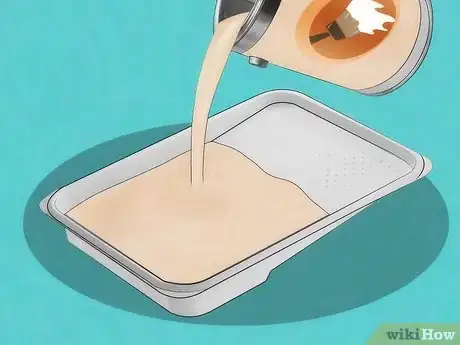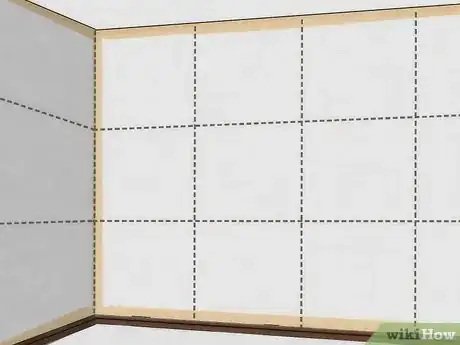This article was co-authored by Patrick Coye. Patrick Coye is the owner and operator of Patrick’s Painting & Home Improvement in Alexandria, Virginia. With over 15 years of experience in residential construction, Patrick specializes in painting, wallpaper removal/installation, drywall, staining decks and fences, and kitchen cabinetry painting. To date, Patrick and his team have painted over 2,000 houses and stained over 800 decks. Patrick's Company won a "Top Job" award from the American Painting contractor magazine in 2020.
wikiHow marks an article as reader-approved once it receives enough positive feedback. In this case, several readers have written to tell us that this article was helpful to them, earning it our reader-approved status.
This article has been viewed 97,608 times.
Emulsion is a water-based paint. Many find it more pleasant to work with than oil-based paints since it produces a less potent odor and is easier to clean. The process of painting a wall with emulsion paint is pretty similar to the process you should follow with all paints, with only a few minor specifics to address.
Steps
Part One: Preparations
-
1Purchase the emulsion. You'll need a basecoat of white emulsion plus an overcoat in any color you'd prefer. Only the overcoat will be seen when finished.
- Emulsion paint comes in three different finishes: vinyl matte, vinyl soft sheen, and vinyl silk. Matte emulsion hides imperfections well, but soft sheen emulsion is more durable. Silk emulsion is the most durable and handles high-moisture areas better than the other two, but its glossiness tends to draw attention to imperfections on the surface of the wall.
- The white basecoat should usually be matte emulsion, but the overcoat can be any of the three varieties.
-
2Gather the right applicator tools. Typically, it's best to "cut in" the paint around the corners of the wall using a paint brush. The rest of the wall should usually be painted with a roller, however.
- A 2-inch (5-cm) paintbrush should work adequately well for cutting in the sides of the wall.
- Lambswool, foam, and mohair rollers can all be used with emulsion paint. As a general rule, you should use a roller with a greater amount of nap (more thickness) for rougher or more uneven surfaces.
Advertisement -
3Clear the area. Before painting, you should remove as many decorations and as much furniture as possible. Cover the floor with a plastic drop cloth to shield it from any stray emulsion.[1]
- If there's a radiator on your wall, consider turning it off and removing it while applying the emulsion paint. Allow the radiator to cool and drain before removing it.
- Turn off or block all electrical outlets. Cover the edges of light switch plates and outlet plates with painter's tape.
- Apply painter's tape over the skirting boards, floor, ceiling, door frame, and window frames immediately adjacent to the wall.
-
4Clean the wall. Scrub the wall down with warm water and mild detergent to remove any oils from the surface. Rinse with clean water and let the surface dry.
- You can scrub, rinse, and dry the wall using clean rags.
- It's very important to let the wall dry before continuing. Since emulsion is a water-based paint, applying it to water-covered surfaces could prevent it from adhering correctly.
-
5Consider sanding the wall. If the current wall surface is glossy or smooth, rubbing it down with 40-grit sandpaper could help the emulsion adhere more effectively.
- Wrap the sandpaper around a cork block and gradually work over the entire surface of the wall.
- When finished, use a lily bristle brush to sweep away any dust from the wall.
Part Two: Understanding the Basic Procedure
-
1Strain and stir the paint. Emulsion that sits in storage will usually develop lumps and skin. It might be a good idea to strain these solid portions and mix the paint before use.
- Check the manufacturer's recommendations since the best mixing practices can vary by brand and make.
- Place tights or cheesecloth over the paint bucket, then pour the paint into a separate bucket through that material. Doing so will generally strain most solid pieces from the paint.
- You should also use a wooden paint stirrer to quickly combine the paint before use.
-
2Apply a basecoat. Using a basecoat will help cover any color or pattern currently on your wall, thereby preventing that original color from showing through your final overcoat of paint.
- To prepare a basecoat, combine one part white emulsion with three parts water in a clean, empty bucket. Use a paint stick to thoroughly blend the mixture.
- Apply the basecoat using the same technique you'll use for the overcoat emulsion. “Cut in” the seams of the wall using a paintbrush, then apply it to the remaining wall surface using a paint roller.
- Allow the basecoat to thoroughly dry before proceeding with the overcoat.
-
3Paint the seams before painting the broader surface. You should “cut in” the emulsion around the seams of the wall using a paintbrush. After the seams are covered, switch to your paint roller and apply the emulsion to the rest of the wall.
- Cutting in should be done around all seams of the wall and in any area the roller won't reach. This includes any area where the wall meets other walls, ceiling, or floor. Additionally, all seams around electrical outlets, light switch plates, doors, and windows should also be cut in.
- Any area that can be easily accessed with a roller should generally be painted with a roller. Other tools, including large paint brushes and paint pads, can be used instead of a roller, but for the sake of ease and consistency, paint rollers are generally best.
-
4Allow the emulsion to dry completely in between coats. You may need to use more than one coat of emulsion, but you should allow each coat to finish drying before applying another one over it.
- This also means that you should allow the white basecoat to dry before applying a top coat in your final color.
- The necessary number of coats will vary depending on the color you choose and the original color of the wall. Dark colors are difficult to paint over and may require as many as three coats, especially if your new paint is lighter.
- For more specific guidelines, check the emulsion manufacturer's recommendations, which can usually be found on the label.
-
5Immediately clean any spills. If any emulsion drops onto the floor or onto another hard surface you don't wish to paint, immediately wipe it away with a damp rag.
- Since emulsion paint is water-based, it's usually easier to clean than oil-based paints. Get to the spill before it dries, however.
- If the spill does dry, you may need to apply an appropriate paint thinner to the area before wiping it clean.
Part Three: Cutting In
-
1Pour the paint. Fill a 2.5 qt (2.5 L) paint kettle or bucket halfway with emulsion. Work with the paint in this kettle during the entire cutting in procedure.
- Use a 2-inch (5-cm) wide paintbrush for best results.
- When dipping the brush into the emulsion, only submerge approximately one-third of the bristle length.
-
2Paint in straight lines. Hold the brush at a 90-degree angle away from the adjacent surface, then apply the emulsion using straight strokes that run parallel to that same adjacent surface.[2]
- Apply the first straight stroke within 1 inch (2.5 cm) of the seam.
- After completely the first stroke, turn the brush so that the long edge is perpendicular to the seam. Work back over the original stroke, carefully pushing the paint into the seam in the process.
- When finished, roughly 2 inches (5 cm) of wall space should be covered by the emulsion. Corners that meet in three dimensions, like the space between two wall corners and a ceiling, may require a slightly wider cutting in area.
-
3Do not wait for the paint to dry. After you finish cutting in the edges, you should immediately begin to emulsion the rest of the wall. Do not wait for the cutting in emulsion to dry.
- If the emulsion does dry completely, the areas you cut in may remain visibly separate from the rest of the painted surface.
Part Four: Painting the Wall
-
1Pour the paint. Pour the emulsion into a paint tray until the tray is roughly one-third full.
- Use a tray specifically designed for use with paint rollers. There should be a sunken well at one end and a ribbed, slanted platform extending up toward the other. Pour the paint directly into the sunken well.
-
2Dampen the roller sleeve. Quickly dunk the soft sleeve of the paint roller in water. Gently squeeze out any excess water before continuing.
- To remove the excess water, pass the roller over clean paper towels or other non-inked absorbent paper material.
- The water will not dilute the color of the emulsion. Since emulsion is a water-based paint, however, water can help the roller apply the paint in smoother, more even strokes.
-
3Load the roller. Dip the paint into the filled well of the roller tray. Spread the paint over the sleeve by passing it up and down the ribbed platform, then lift the roller out of the tray.
- You only need to apply a light coat of paint to the roller. If emulsion drips off when you lift it up, there's too much on it. Roll the roller over the platform again to scrape away some of the excess.
-
4Visually divide the remaining wall space. Mentally divide the remaining wall into 1-yard (1-meter) squares. Paint the wall one square at a time until the entire surface is covered.[3]
- Tackle the square in the top corner first. If one corner is closer to a window than the other, choose that one since the sunlight can make it easier for you to check the application and coverage of the emulsion.
-
5Work in M-shaped strokes. Place the loaded roller in the center of the square, then roll over the all in diagonal M-shaped strokes.
- Start at the bottom of one side and work toward the opposite side.
- After the first "M," you'll need to lift the roller and create another "M" over the first. This second "M" should be perpendicular to the first.
- Repeat these diagonal strokes, reloading the paint as needed and changing the angle periodically, until the entire square has been covered.
-
6Cover your original strokes with vertical strokes. After covering the entire square with diagonal M-shaped strokes, roll over the area in parallel vertical strokes.
- Overlap the strokes slightly so that the emulsion blends together evenly.
- Try to overlap the paint onto the "cut in" areas around the seams of the wall.
Community Q&A
-
QuestionWhen we paint it is necessary to add some water for mixing the paint or good finish?
 Community AnswerNot necessary, but it helps to make a spreadable consistency and makes your paint last longer because you use less. The finish looks the same, but can become flaky if you use too much water.
Community AnswerNot necessary, but it helps to make a spreadable consistency and makes your paint last longer because you use less. The finish looks the same, but can become flaky if you use too much water. -
QuestionCan I paint silk paint directly onto silk?
 Community AnswerOnce you have prepped the wall, you can. You can paint silk on top of silk, Matt on top of matt, silk on top of matt but you can't put matt on top of silk unless you sand the wall first. If you're going to do that, make sure you sand the sheen off.
Community AnswerOnce you have prepped the wall, you can. You can paint silk on top of silk, Matt on top of matt, silk on top of matt but you can't put matt on top of silk unless you sand the wall first. If you're going to do that, make sure you sand the sheen off. -
QuestionIs it necessary to sand lightly between coats?
 Community AnswerDoing that is usually not needed, unless the surface is showing cracks or rough filler patches.
Community AnswerDoing that is usually not needed, unless the surface is showing cracks or rough filler patches.
Things You'll Need
- Emulsion paint
- 2-inch (5-cm) wide paintbrush
- Paint roller
- 2.5 qt (2.5 L) paint kettle or plastic bucket
- Paint tray
- Painter's tape
- Plastic drop cloth
- Water
- Mild detergent
- Rags
- 40-grit sandpaper
- Cork block
- Paint stirring

















































































